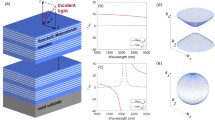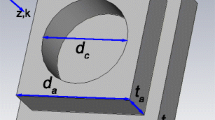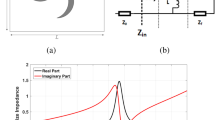Abstract
In order to achieve nonreciprocal absorption, we design a metamaterial slab made of arrays of tilted metal layers. Through studying the extraordinary material dispersion, we derive the transfer matrix to calculate its transmittance and absorption. Given specific conditions and two opposite incidence directions, the slab can achieve total absorption for one direction and total transmittance for the other direction. The designed structure is demonstrated to be a perfect nonreciprocal absorber.








Similar content being viewed by others

References
Wang Z, Chong YD, Joannopoulos John D, Soljacic M (2008) Reflection-free one-way edge modes in a gyromagnetic photonic crystal. Phys Rev Lett 100(1):013905
Rechtsman MC et al (2013) Photonic floquet topological insulators. Nature 496(7444):196–200
Hafezi M, Demler EA, Lukin MD, Taylor JM (2011) Robust optical delay lines with topological protection. Nature Phys 7(11):907–912
Khanikaev AB et al (2013) Photonic topological insulators. Nature Mater 12(3):233–239
Fang K, Yu Z, Fan S (2012) Realizing effective magnetic field for photons by controlling the phase of dynamic modulation. Nature Photon 6(11):782–787
Fang YT, He HQ, Hu JX (2016) Transforming unidirectional edge waveguide into unidirectional air waveguide. IEEE J. Sel Top Quantum Electron 22:4901109
Atwater HA, Polman A (2010) Plasmonics for improved photovoltaic devices. Nat Mater 9(3):205–213
Sai H et al (2003) Solar selective absorbers based on two-dimensional W surface gratings with submicron periods for high-temperature photothermal conversion. Sol Energy Mater Sol Cells 79(1):35
Tittl A et al (2011) Palladium-based plasmonic perfect absorber in the visible wavelength range and its application to hydrogen sensing. Nano Lett 11(10):4366
Du QG, Kam CH, Demir HV, Yu HY, Sun XW (2011) Enhanced optical absorption in nanopatterned silicon thin films with a nano-cone-hole structure for photovoltaic applications. Opt Lett 36(9):1713–1715
Lee J, Zhang ZM (2006) Design and fabrication of planar multilayer structures with coherent thermal emission characteristics. J Appl Phys 100(6):063529
Narayanaswamy A, Chen G (2004) Thermal emission control with one-dimensional metallodielectric photonic crystals. Phys Rev B 70(12):125101
Yu Z, Fan S (2009) Complete optical isolation created by indirect interband photonic transitions. Nature Photon 3(2):91–94
Nefedov IS, Valagiannopoulos CA, Hashemi SM, Nefedov EI (2013a) Total absorption in asymmetric hyperbolic media. Sci Rep 3(9):2662
Nefedov IS, Valagiannopoulos CA, Melnikov LA (2013b) Perfect absorption in graphene multilayers. J Opt 15:114003
Hashemiand SM, Nefedov IS (2012) Wideband perfect absorption in arrays of tilted carbon nanotubes. Phys Rev B 86:195411
Barnes WL (2006) Surface plasmon polariton length scales: a route to sub-wavelength optics. J Opt A: Pure Appl Opt 8:S87–S93
Acknowledgements
This work was supported by the Senior Talent Foundation of Jiangsu University under Grant No. 13JDG003.
Author information
Authors and Affiliations
Corresponding author
Appendix
Appendix
In the coordinate system x’y’z’, the electric displace vector D 'and electric filed vector E 'satisfies
where
When the coordinate system x’y’z’ is rotated anticlockwise around y’ axis for an angle of φ, the basic vectors in the new coordinate system xyz and old coordinate system x’y’z’ have the following relation
where \( \mathrm{P}=\left[\begin{array}{ccc}\hfill \cos \varphi \hfill & \hfill 0\hfill & \hfill \sin \varphi \hfill \\ {}\hfill 0\hfill & \hfill 1\hfill & \hfill 0\hfill \\ {}\hfill \hbox{-} \sin \varphi \hfill & \hfill 0\hfill & \hfill \cos \varphi \hfill \end{array}\right] \).
In the new coordinate system xyz, the electric displace vector D and electric filed vector E satisfies
where
Rights and permissions
About this article
Cite this article
Fang, Yt., Zhang, Yc. Perfect Nonreciprocal Absorption Based on Metamaterial Slab. Plasmonics 13, 661–667 (2018). https://doi.org/10.1007/s11468-017-0558-5
Received:
Accepted:
Published:
Issue Date:
DOI: https://doi.org/10.1007/s11468-017-0558-5



